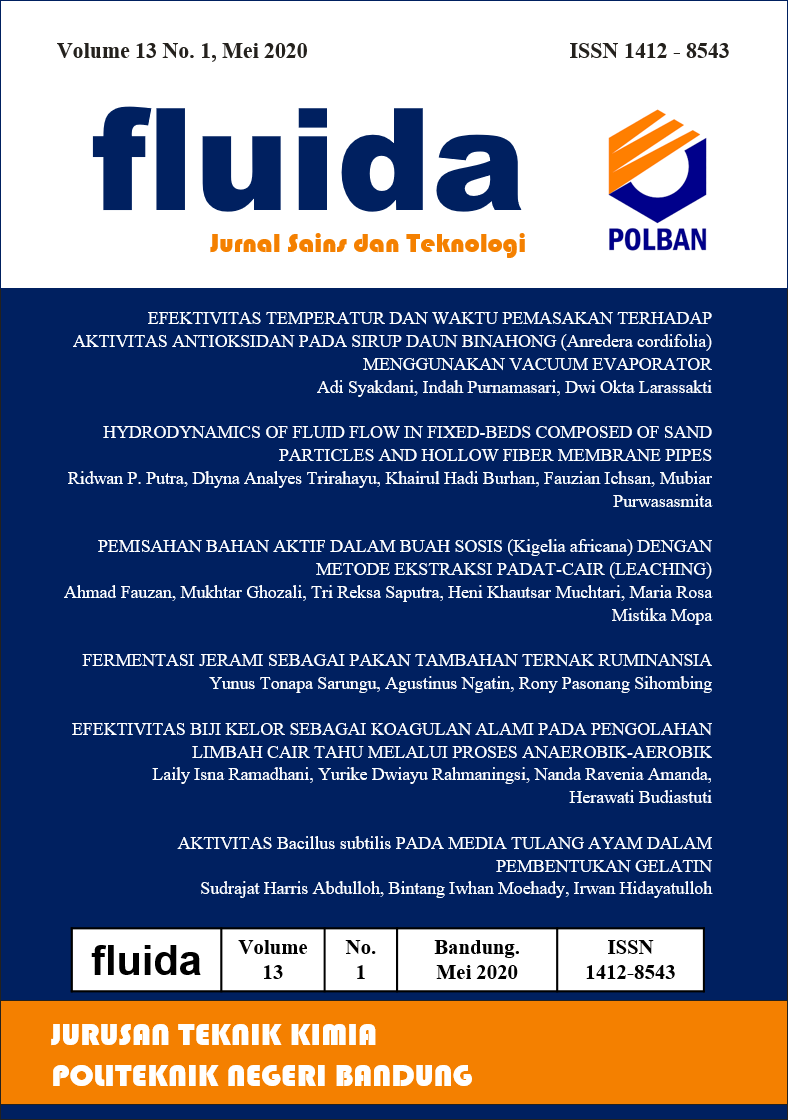Hydrodynamics of Fluid Flow in Fixed-Beds Composed of Sand Particles and Hollow Fiber Membrane Pipes
Main Article Content
Abstract
ABSTRAK
Kompos artifisial yang dibuat dari bahan polimer baru-baru ini menarik perhatian peneliti sebagai pupuk yang tahan lama dan dapat meningkatkan produktivitas tanaman tanpa menimbulkan dampak yang besar pada lingkungan. Dalam penelitian ini, pipa membran hollow fiber (HFMP) yang terbuat dari bahan polipropilen dan pasir kuarsa, masing-masing digunakan sebagai model kompos artifisial dan partikel tanah. Hidrodinamika unggun yang terdiri dari HFMP dan pasir kuarsa diteliti dengan menggunakan metode falling-head. Hasil percobaan menunjukkan bahwa unggun yang ditambahkan HFMP mengalami peningkatan porositas unggun. Unggun dengan fraksi HFMP yang lebih tinggi menunjukkan kemampuan menahan air yang lebih rendah, yang mengindikasikan kemampuan yang buruk dari bahan polipropilen dalam menahan molekul air. Sebaliknya, permeabilitas yang lebih tinggi pada unggun yang ditambahkan HFMP menunjukkan aliran cairan yang lebih baik. Studi ini mengungkap potensi kompos artifisial yang dapat diterapkan dalam teknologi pertanian berkelanjutan.
Kata kunci: Hidrodinamika, kapasitas menahan air, porositas, permeabilitas, kompos buatan
ABSTRACT
Artificial compost fabricated from polymer materials has recently attracted considerable interest as a highly durable fertilizer that could enhance plant productivity without harming the environment. In this study, polypropylene hollow fiber membrane pipes (HFMP) and quartz sand particles were employed as models of the artificial compost and soil particles, respectively. The hydrodynamics of various volumetric ratios of beds composed of the HFMP and the quartz sand were investigated using a falling-head technique. The results show that the bed supplemented with the HFMP demonstrated enhanced bed porosity. The bed with a higher HFMP fraction exhibited slightly less water-holding capacity, which suggests the poor ability of the polypropylene material to retain water molecules. On the contrary, the higher permeability of the bed amended with the HFMP indicates improved water flow. This study unfolds the potential of artificial compost that can be implemented in sustainable agricultural technology.
Keywords: Hydrodynamics, water-holding capacity, porosity, permeability, artificial compost
Downloads
Article Details

This work is licensed under a Creative Commons Attribution-ShareAlike 4.0 International License.
An author who publishes in the FLUIDA journal agrees to the following terms:
- Author retains the copyright and grants the journal the right of first publication of the work simultaneously licensed under the Creative Commons Attribution-ShareAlike 4.0 License that allows others to share the work with an acknowledgement of the work's authorship and initial publication in this journal
- Author is able to enter into separate, additional contractual arrangements for the non-exclusive distribution of the journal's published version of the work (e.g., post it to an institutional repository or publish it in a book) with the acknowledgement of its initial publication in this journal.
- Author is permitted and encouraged to post his/her work online (e.g., in institutional repositories or on their website) prior to and during the submission process, as it can lead to productive exchanges, as well as earlier and greater citation of the published work (See The Effect of Open Access).
Read more about the Creative Commons Attribution-ShareAlike 4.0 Licence here: https://creativecommons.org/licenses/by-sa/4.0/.
References
Chaganti, V. N.; Crohn, D. M.; & Simunek, J., 2015. Leaching and reclamation of a biochar and compost amended saline–sodic soil with moderate SAR reclaimed water. Agric. Water Manag., (158): 255–265.
Fauzan, A.; & Rispiandi, R., 2020. The influence size and composition of bioreactor from sand and compost to improve hold up liquid of bed. IOP Conf. Ser.: Mater. Sci. Eng., (830): 022016.
Kahavita, K. D. H. N.; Samarasekara, A. M. P. B.; Amarasinghe, D. A. S.; & Karunanayake, L., 2019. Influence of surface modification of cellulose nanofibers (CNF) as the reinforcement of polypropylene based composite. 2019 Moratuwa Engineering Research Conference (MERCon), (1): 99-104.
Mosaddeghi, M. R.; Hajabbasi, M. A.; Hemmat, M.; & Afyuni, M., 2000. Soil compactibility as affected by soil moisture content and farmyard manure in central Iran. Soil Tillage Res., (55): 87-97.
Nawaz, M.F., Bourrié, G. & Trolard, F., 2013. Soil compaction impact and modelling. A review. Agron. Sustain. Dev., (33): 291–309.
Pambayun, W. S.; Purwasasmita, M.; & Urahman, T., 2015. Hydordynamic analysis of compost soil mixture and its implication on growth and potassium uptake in corns (Zea mays L.). MATTER: Sci. Eng., (1): 35–47.
Pourjavadi, A.; Doulabi, M.; Soleyman, R.; Sharif, S.; & Eghtesadi, S. A., 2012. Synthesis and characterization of a novel (salep phosphate)-based hydrogel as a carrier matrix for fertilizer release. React. Funct. Polym., (72): 667–672.
Purwasasmita, M.; & Hadi, K., 2015. Model hidrodinamika bioreator tanaman: konsep peremeabilitas. Reaktor, (15): 154–164.
Torres, F. G.; Troncoso, O. P.; Torres, C.; Diaz, D. A.; & Amaya, E., 2011. Biodegradability and mechanical properties of starch films from Andean crops. Int. J. Biol. Macromol., (48): 603–606.
Tschapek, M.; Wasowksi, C.; & Falasca, S., 1983. Character and change in the hydrophilic properties of quartz sand. Z. Pflanzenernaehr. Bodenk., (146): 295–301.
Yan, Z.; Liu, C.; Todd-Brown, K. E.; Liu, Y.; Bond-Lamberty, B.; Bailey, V. L., 2016. Pore-scale investigation on the response of heterotrophic respiration to moisture conditions in heterogeneous soils. Biogeochemistry, (131): 121–134.
Yamamoto, C. F.; Pereira, E. I.; Mattoso, L. H. C.; Matsunaka, T.; & Ribeiro, C., 2016. Slow release fertilizers based on urea/urea–formaldehyde polymer nanocomposites. Chem. Eng. J., (287): 390–397.
Yu, Y.; Zhao, C.; Zhao, Z.; Yu, B.; & Zhou, T., 2015. Soil respiration and the contribution of root respiration of cotton (Gossypium hirsutum L.) in arid region. Acta Ecol. Sin., (35): 17–21.
Zhang, X.; Ge, J.; Zhang, S.; Zhao, Y.; Cui, H.; Wei, Z.; Luo, S.; & Cao, J., 2019. Bioavailability Evaluation of Dissolved Organic Matter Derived from Compost-Amended Soils. J. Agric. Food Chem., (67): 5940–5948.

